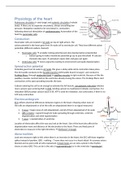Samenvatting
summary Human antomy and physiology
- Instelling
- Vrije Universiteit Amsterdam (VU)
Samenvatting van human antomy and physiologie hoorcollege aantekeningen gecombineerd met het boek: fundamentals of anatomy and physiology. geschreven in het engels.
[Meer zien]





